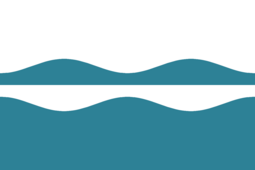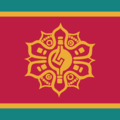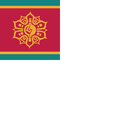Flag and emblem of Mava: Difference between revisions
| Line 46: | Line 46: | ||
File:Flag of the Administrator of Mava.png| Standard of the Administrator | File:Flag of the Administrator of Mava.png| Standard of the Administrator | ||
</gallery> | </gallery> | ||
==See also== | ==See also== | ||
Revision as of 10:23, 15 July 2023
 | |
| Name | Kaamatuulikalat ("Our Blue Flag") |
|---|---|
| Use | National flag and ensign |
| Proportion | 2:3 |
| Adopted | 10 April 1978 |
| Design | A horizontal bicolour of white and blue, with a counterchanged wave mirrored horiontally. |
The flag of Mava is composed of a horizontal bicolour of white (top) and blue (bottom), countercharged with a stylised wave in the centre. The flag was adopted by the Mava Council on 10 April 1978, proclaimed by Administrator Nakulaq Inamuyak on behalf of Governor Antonio Jose Abarquero on 4 September 1978, and first officially hoisted on 8 January 1979 .
Status and protocol
The flag of Mava is officially recognised as the flag of Mava and may be flown to represent the territory domestically and internationally. The Atitlanese flag may also be flown, but precedence must be given to the flag of Mava. This is different from the states of Atitlan, which must give precedence to the Atitlanese national flag.
The Mavean flag is flown from all government buildings all-year round, although they are only required to be flown on select days as approved by the Council. There are no restrictions on the flag's use by private individuals, who are encouraged to fly the flag, although there are limitations on its use by businesses and enterprises.
There are no laws against flag desecration.
Design and symbolism
The colours and symbols of the flag carry cultural and geographical meanings. The general design, featuring a mirrored wave, symbolises the landscape as seen arriving from the ocean, symbolising the "return home" as well as being a visible reference to the flag's intention to represent the island. The colour scheme also has geographical significance, representing the sea and snow which predominate life in Mava. The design was first described in the Flag Act (Mava) 1978, with more detailed specifications laid out in the National Symbols (Specifications) (Mava) Act 1992.
The aspect ratio of its length to breadth is 3:2, the same as the Atitlanese flag.
Colour scheme
Colors scheme |
Blue | White |
|---|---|---|
| RGB | 66-127-148 | 255-255-255 |
| Hexadecimal | #417F94 | #FFFFFF |
| CMYK | 32, 8, 0, 42 | 0, 0, 0, 0 |
History
Mava came under Atitlanese sovereignty in 1829 when the Mavean chiefs formally relinquished control to the resident Atitlanese military command. During the period of Atitlanese rule, Mava had no unique flag. Where a unique flag was required, the flag of the Governor of Mava was used (the Atitlanese flag charged with the coat of arms of Mava). This flag has since become the de facto flag of colonial Mava and is widely used as such in historical displays and exhibitions.
When it became clear that independence was inevitable, the Legislative Council (the home-rule government) initiated a competition to design a new flag. The eventual flag was selected by the Council on 18 June 1924, although the resolution adopting it was not official and the flag continued to have no formal status in law. On independence, the newly-established Council of State adopted the flag as part of the first series of "Orders in Council" issued by the new president. The order did not establish the specifications of the flag beyond broad design requirements, resulting in a variety of colour schemes and variants arising. In 1929, the Flag Act formalised the design.
In the 1980s, a small artistic commune in Paas proposed an amendment to the flag, rotating it 180 degrees so that the base is white. The proposal, which sought to emphasise peace and harmony, was dismissed by the government of Niqimuyaak Maait.
Gallery
See also
- Politics of Mava
- Culture of Mava
Notes
External links
- Flag of Mava. International Flag Database

